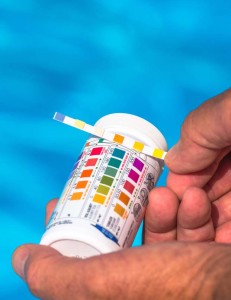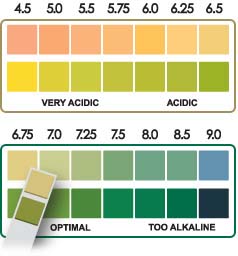Nutrient Absorption Occurs BELOW 7.2 pH
– by Colle and Phyllis Davis
 If the pH gets too near or above 7.2 in your Portable Farms® Aquaponics System’s Fish Tank, your plants cannot absorb the nutrients in the system and creates a NUTRIENT SHUTDOWN and your plants will begin to wither, show systems of leaf curl, begin to yellow, have stunted growth and not produce growth or blossoms. In effect, the plants are starving to death.
If the pH gets too near or above 7.2 in your Portable Farms® Aquaponics System’s Fish Tank, your plants cannot absorb the nutrients in the system and creates a NUTRIENT SHUTDOWN and your plants will begin to wither, show systems of leaf curl, begin to yellow, have stunted growth and not produce growth or blossoms. In effect, the plants are starving to death.
The Portable Farms® Aquaponics Systems are designed to accomplish this adjustment in an extremely easy manner. Checking the pH in your system at least a couple of times per week is vital, especially as the vegetables approach harvest time; this is an inexpensive process to increase production in the grow trays. This simple checking and adjustment will result in more bountiful harvests of healthy and nutritious produce.
Each plant has a preferred range of pH, or parts Hydrogen, that creates an ideal growing environment for the plant.
 In aquaponics, this adjustment is very easily when the water flows through the system. To ‘increase’ the pH means to make the solution more alkaline and to ‘decrease’ the pH means to make the solution more acidic. There are quick and very inexpensive ways to change the pH of water in an aquaponics system.
In aquaponics, this adjustment is very easily when the water flows through the system. To ‘increase’ the pH means to make the solution more alkaline and to ‘decrease’ the pH means to make the solution more acidic. There are quick and very inexpensive ways to change the pH of water in an aquaponics system.
When adding any agent to adjust the pH levels in your system, allow several hours, and better yet, monitor your system over a day or two before trusting the testing medium results.
Testing can be done with simple swimming pool test strips or with sophisticated scientific instruments that have been designed for the task. Both work very well and if you use both, be prepared to have two very different readings. What you are looking for is consistency using one method. Using both is confusing and makes adjusting the water much harder. (We know from experience . . .)
We check the pH in our fish tanks two or more times per month to make sure the pH is below 7.2.
Each plant has a preferred range of pH, or parts Hydrogen, that creates an ideal growing environment for the plant.
- Plants in Portable Farms Aquaponics Systems prefer a pH in the 5.8 to 6.8 range, or even a slightly lower range.
- Fish prefer a little higher pH and to keep both organisms happy, the water in an aquaponics system needs to be adjusted.
The measurement of pH is how acidic (6.9 and below) or alkaline (7.1 or above) a liquid is at any specific moment. This pH measurement is not about the water’s hardness, that is a measurement of the dissolved mineral content in the water, and it is measured in a different way.
In aquaponics, this adjustment is very easily when the water flows through the system. To ‘increase’ the pH means to make the solution more alkaline and to ‘decrease’ the pH means to make the solution more acidic. There are quick and very inexpensive ways to change the pH of water in an aquaponic’s system.
If you are trying to grow vegetables with very different pH requirements in the same grow tray, plant the heavy feeders at the beginning (top) end of the tray and furthest from your fish tank, where the water flows into your grow tray, favoring their pH requirement and the light feeders at the end where the water flows out.
 When adding any agent to adjust the pH levels in your system, allow several hours, and better yet, monitor your system over a day or two before trusting the testing medium results.
When adding any agent to adjust the pH levels in your system, allow several hours, and better yet, monitor your system over a day or two before trusting the testing medium results.
Testing can be done with simple swimming pool test strips or with sophisticated scientific instruments that have been designed for the task. Both work very well and if you use both, be prepared to have two very different readings. What you are looking for is consistency using one method. Using both is confusing and makes adjusting the water much harder. (We know from experience . . .)
We use a Microprocessor Conductivity & TDS Meters with Automatic Temperature Compensation with Automatic Calibration to check the water in our systems (image left).

6 pings